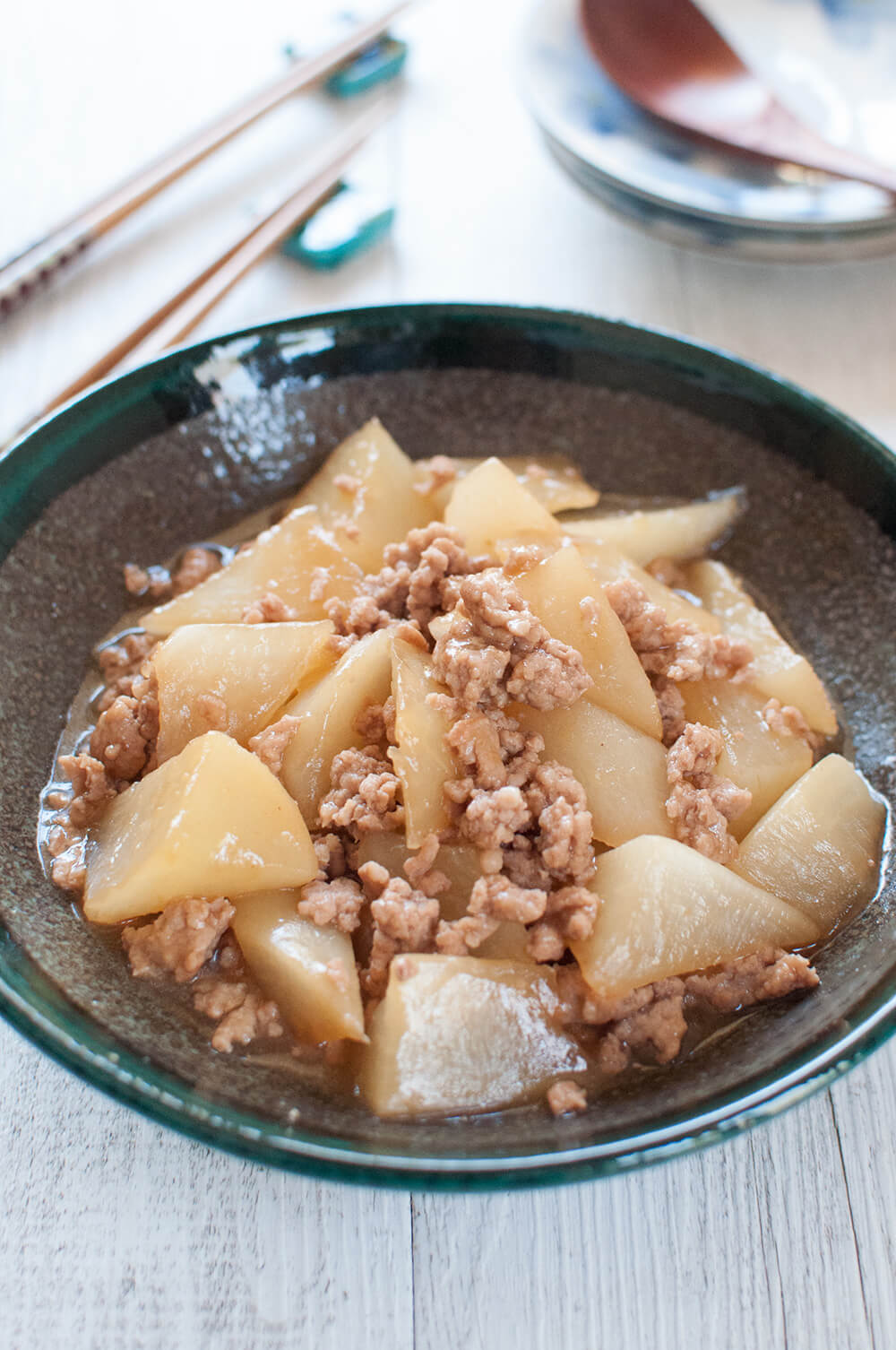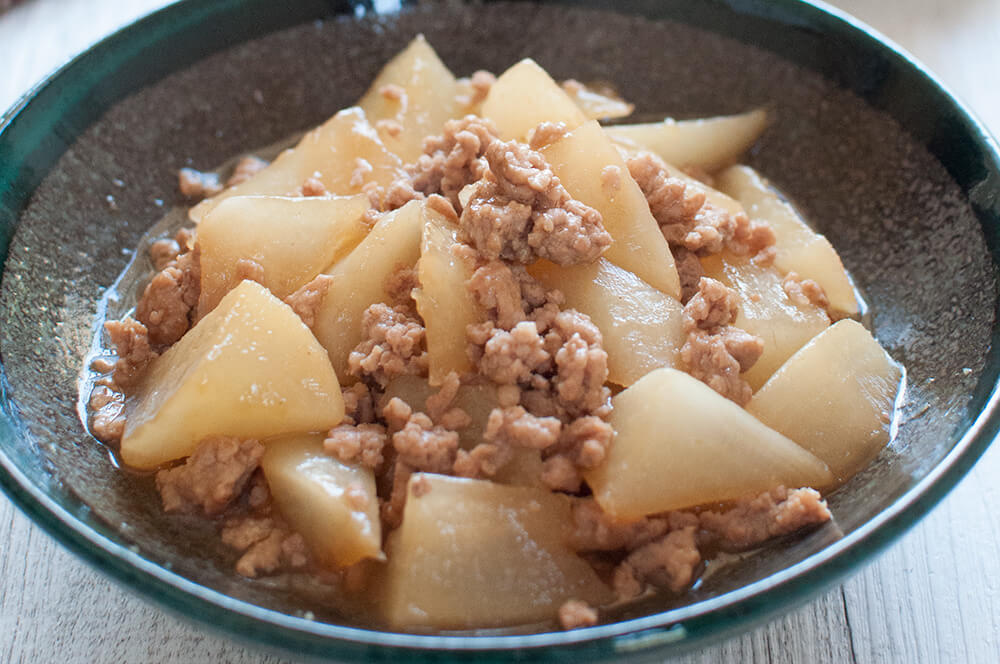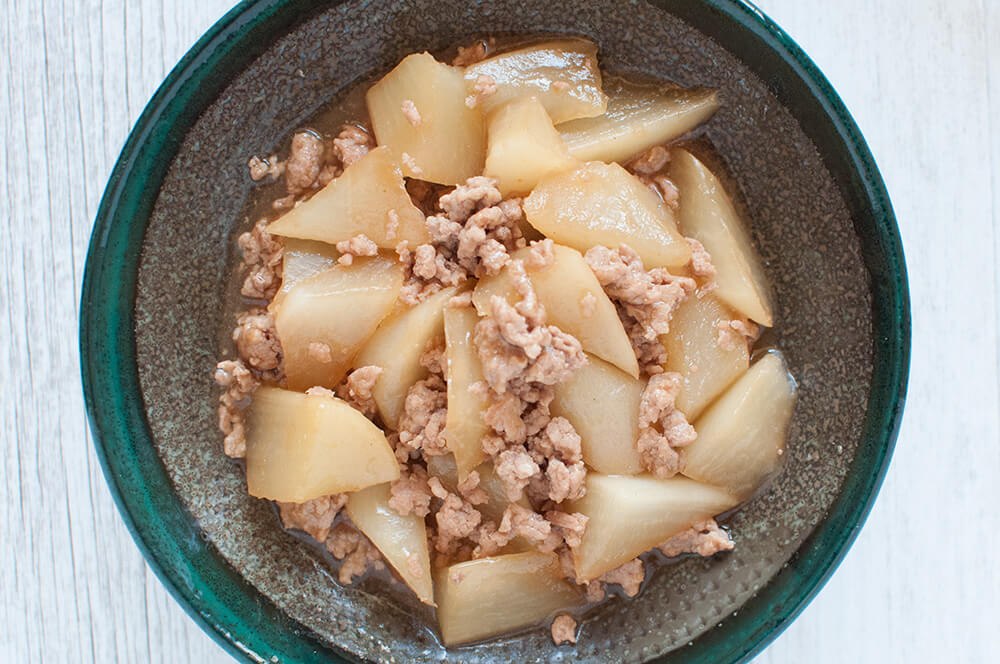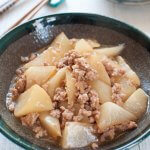A simple braised white radish (daikon) becomes a surprisingly tasty dish when cooked in a thick soy flavoured sauce with pork mince (ground pork). The daikon is cooked until it becomes semi-transparent and tender. The meat sauce has a typical Japanese flavour with dashi, soy sauce, sake, mirin and sugar.

I have already shared few dishes using daikon such as Beef with Daikon and Ponzu Dressing, Oden (Simmered One Pot Dish) and Rice with White Radish (Daikon Takikomi Gohan). And this is another daikon dish but the way daikon is cooked in this dish is quite different from other dishes.
When I buy a whole daikon, I have to cook various dishes that call for daikon. The amount of daikon is too much for me to consume in a single dish as I live on my own. Braised White Radish with Pork Mince is one of the dishes I cook often as I can use up a large amount of daikon.
Japanese flavoured thick meat (mince/ground meat) sauce is called ‘soboro-an’ (そぼろあん) in Japanese. Mince (ground meat) can be any kind of meat. When mince is cooked and flavour is added, it becomes ‘soboro’ (そぼろ). When soboro is cooked in thick sauce, it becomes soboro-an.
The sauce is a typical Japanese flavour – dashi stock, soy sauce, sake, mirin and sugar.

Soboro-an goes well with various vegetables. Instead of white radish, you can use turnip or pumpkin. You can also sauté eggplant or boil tofu and pour soboro-an over to add flavour to the vegetables.
As you can see in the photo, I used a roll cutting method to cut daikon. It is called ‘rangiri’ (乱切り) in Japanese and direct translation of the word ‘rangiri’ is random cut. I like roll cutting because the shape looks interesting and the vegetables cook evenly. I talked about roll cutting in my recipe, Sweet and Sour Pork Meatballs (Subuta), using a carrot as an example.
Unlike carrot, daikon root is rather thick so it needs to be cut vertically in half or quarters before roll cutting. My daikon was quite thick so I quartered it to make four long logs before roll cutting each log.
You can cut daikon in different ways if you like. You could cut into thick discs and then halve/quarter it into bite size pieces. But either way, it is important to cut the daikon into similar size pieces so that all pieces will be cooked through at the same time.
When cooking simmered daikon, it is a common practice in Japan to pre-boil it with a handful of rice or the cloudy water you get when you wash rice. Pre-boiling daikon serves two purposes – (1) it allows daikon to absorb flavours more easily, and (2) it eliminates bitterness and brings out the sweetness in the daikon.
When the starch from rice diluted in the water and the enzyme called amylase in daikon meet together, it produces sugar and makes daikon sweeter. You need to boil the daikon until it is almost cooked through. Do not cook too much.
I sometimes skip this process especially when the daikon is very fresh. But when daikon is the star of the dish such as today’s recipe, I do pre-cook it. You may want to try this pre-cooking method and compare the difference.

Braised White Radish with Pork Mince is a simple dish but very tasty. It is considered to be a winter dish because white radish is a winter vegetable in Japan and the thick sauce keeps the dish warm for a longer period.
But whenever daikon is available, I don’t mind having this any time of the year.
Yumiko![]()

A Simpley braised white radish (daikon) becomes a surprisingly tasty dish when cooked in a thick soy sauce flavoured sauce with pork mince (ground pork). Daikon is cooked until it becomes semi-transparent and tender. The thick sauce has a typical Japanese flavour with dashi, soy sauce, sake, mirin and sugar.
- 400 g (0.9lb) daikon (white radish) cut into bite size rangiri (roll cutting, note 1)
- A handful of rice
- 250 g (0.6lb) pork or chicken mince (ground pork or chicken)
- 1 tsp oil
- 1 cup (250ml/8.5oz) dashi stock (note 2)
- 2 tbsp (40ml/1.4oz) soy sauce
- 1 tbsp (20ml/0.7oz) each sake, mirin
- ½ tbsp sugar
- 1 tsp heap of grated ginger
- ½ tbsp corn flour (corn starch) diluted in ½ tbsp water
-
Place daikon and rice in a pot (note 4) , then add water, enough to cover daikon.
-
Boil for 10 minutes or until daikon is nearly cooked through (a bamboo skewer can get through the daikon). Drain hot water, and run cold water to rinse quickly with cold water , then and drain well.
-
Heat oil in a deep frypan over medium heat, add pork/chicken mince and fry, breaking the lumps. Cook until the meat changes colour to pale brown.
-
Add daikon and stir. Add the remaining ingredients, except corn flour with water, and place a drop lid (note 3) over to cover the surface.
-
When it starts boiling, reduce the heat to low and cook for 10 minutes.
-
Remove the drop lid, add corn flour with water and mix well.
-
When the sauce is thickened, turn the heat off and serve immediately.
1. Step-by-step photos of rangiri (roll cutting) are found in my recipe, Sweet and Sour Pork Meatballs (Subuta), using a carrot as an example.
Because daikon is rather thick, unlike carrot, I firstly cut it vertically into 4 equal size sticks. Then cut each stick using the rangiri method.
2. Instead of making dashi stock from scratch, you can dilute 1 teaspoon of granular dashi stock powder in 250ml (8.5oz) water.
You can buy granular dashi stock at Japanese/Asian grocery stores. You will find details and sample photo of stock powder in Home Style Japanese Dashi Stock.
3. A drop lid is called 'otoshi buta' (落し蓋) in Japanese. It is a round lid that is slightly smaller than the opening of a saucepan. It is traditionally made of wood but I have a stainless steel lid. It is placed on top of the ingredients in a pot to ensure the heat is evenly distributed, ingredients cook faster, and stay in place without breaking apart. It also stops the liquid from evaporating quickly.
If you don’t have a drop lid, you can make one with aluminium foil or baking paper. Cut a square out of foil/paper, trim the edges to make it a round shape with the diameter slightly smaller than the pot. Then poke the foil/paper with a knife or a chopstick to make holes in several places.
4. Boiling daikon with rice serves two purposes – (1) it allows daikon to absorb flavours more easily, and (2) it eliminates bitterness and brings out the sweetness in the daikon.
Hi Yumiko san, I am a bit confused about the dashi stock. Which part of the recipe is it used please? Thanks!
Hi Lydia, in step 4 of the recipe instruction, it says ‘add remaining ingredients’, which includes dashi among all other seasonings (except corn flour as indicated).
I hope you enjoy Daikon no Soboro-an.
What do I do with the rice when I have partially cooked the daikon? Should I discard the rice
?
Hi Serena, I discard the rice.
All I had was ground pork and daikon radish, so I did a Google search for a recipe with just that, not expecting much. Holy cow! These flavors are amazing together! I will definitely make this again! Thank you, Yumiko-san!
Hi Sara, just daikon and ground pork was all you needed, right? I am glad that you enjoyed it!
Thank you Yumiko..
This is a great recipe, easy to prepare and delicious!
My son said he can eat this everyday!
Hi Jen, wow, that is a great compliment from your son! You must be very happy to hear that.
Really delicious recipe. I love your simpler, traditional recipes with light flavours, as they are so comforting to eat.
Thanks Jenny.
Hi Jenny, thanks a lot! I like the simple and lightly flavoured dishes too.
Yumiko-san… Thank you so much for sharing this simple and delicious recipe!
My 89-year old (Japanese) father now prefers simple Japanese dishes that are easy for him to eat and I am always looking for new recipes. This one fit the bill perfectly! I will continue trying more recipes on your website.
Hi Kaori-san, I like simple food with light flavouring too. I can totally understand your father’s feeling towards food. There are many traditional dishes on my site and I hope you find them helpful.
Simply the best comfort food!
Hi Lowey, totally agree!
Yumiko-san– Excellent recipe! I appreciated the tip about boiling the daikon with a handful of rice; I’ve cooked daikon for years and had not tried your method. Noticeable change in flavor (to me, anyway). My wife scarfed this down and claims she could eat this every day.
We subbed maple syrup in place of sugar (Ran out of sugar!) and aside from a slight aroma of maple, the recipe was still delish! Absolutely a do again.
Thanks as always!
Joey & Quynh
Hi Joe, cooking daikon with rice does make a difference, doesn’t it? It also makes daikon marginally whiter, although it is not apparent in this particular dish. I’m glad you and your wife liked it!
Thank you for this wonderful recipe. It will definitely be a regular on my family table. Can I ask though, why do you add a handful of rice with the daikon? Thank you.
Hi Michelle, pre-boiling daikon serves two purposes – (1) it allows daikon to absorb flavours more easily, and (2) it eliminates bitterness and brings out the sweetness in the daikon.
Explanation is in my post but perhaps I should add this in the note!